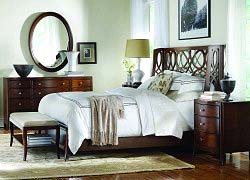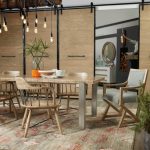In our blog last week, we shared the plight of Michele in Virginia, who knows that her home is not all she wants it to be, but is afraid to step out and take a chance with creative decorating. Since many people may be in the same boat, we are offering some ideas for overcoming decorating inertia. Part 1 covered Steps 1 and 2. Today we will continue with Steps 3 through 5:
• Step 3: Begin small. Wow, a whole house is intimidating, no matter how much confidence one might have. I think a bedroom is a wonderful way to begin to flex your decorating muscles. Perhaps you have an extra bedroom that gets ignored most of the time? Relish in getting it ready for a guest’s overnight stay. Bedroom furniture collections are pretty well established so your creativity comes mostly in soft furnishings. How far wrong can you go with new sheets and pillowcases? If you love white, maybe pick linens with a little detail or a muted design. Always remember: Everybody loves white. Maybe it’s like ice cream.
Think of the small touches you can add–a bookshelf with family albums to entertain your guest, or books on local attractions. And if you are wary of hanging a picture, you don’t have too many wall choices after the mirror over the dresser takes up a good chunk of space. Think of what would delight a guest when first light welcomes them to your home.
• Step 4: The leaning and changing scenario. Before you get out the hammer and nails, lean a picture on a chest or side table before you commit to its permanent place. Notice in lots of magazines there are pictures and paintings leaning all over the place? That’s because decorators, in particular, use them to define space–for the moment. I often have windowsills as temporary habitats for pictures I’m thinking of using in a room. Whisk it away in a second if you change your mind.
Of course, you can’t go changing everything in a room around as easily as you can with pictures. But chairs and small pieces of furniture, such as side tables and accessories, can make a major change in the appearance of a room simply by where you put them. So make a change or put something in position and live with it for a while. If it doesn’t suit, just pick it up and give your room a different feel. This is a good technique for new additions as well.
• Step 5: Evolve and forgive. Chances are, you are going to be happy as you progress with decorating your home, remembering that it’s a process not engraved in the sands of time. Even things that are lovely have a time for change. That proves that there are no “end of the story” choices. And if there is something you do, like painting a wall or hanging a picture, that makes you unhappy, change it and mark it up to a learning experience.
Decorating is very forgiving…because it has no real rules. The key is: All decorating is personal. So start out with a deep breath and find the joy of home that’s yours alone affords. Leave a comment and let us know what you think.












{ 5 comments… add one }
More great ideas! I have found, especially, for guest rooms, the key is to sleep in it yourself! You’ll immediatly know if the light is in the right place; what you WISH you had in easy reach (a bedside table to hold tissues, a little dish for rings and things, a remote for the TV), whether or not the curtains keep out (or let in) light, etc. I learned more in ONE “sleepover” in my guest room than in hours thinking about it…
Kay Marline
Love these suggestions, especially the fourth. Great and forgiving ideas.
Thanks!
What a wonderful idea about leaning pictures in rooms where you might want them! I have an abundance of things I want to hang on my walls but as I live in an apartment I’m not keen on knocking lots of holes in the walls so a way to get a feel for things before committing is perfect. Thanks!
As a professional educator, I always remind myself that when children are learning, exploring, and doing, the process is more important than the product. When attempting to decorate our city apartment, I try to be as focused on the result as I am on the process. Simple design suggestions like these are very helpful because I get to enjoy the final outcome as well as the process that leads to decorating success. Many thanks for the hand-holding.
I’m a big believer in the use-what-you-have style of decorating, which basically complements your ideas for achieving a personal style. A pillow here, a framed painting or photo there — and before you know it, a special space is enhanced with many personal touches.